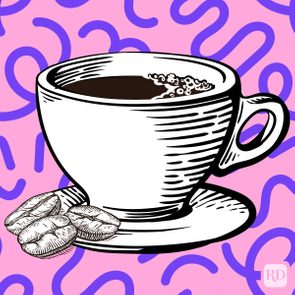Nope, that number isn’t random!

Here’s Why an Espresso Martini Is Garnished with Three Coffee Beans

From swanky cocktail bars to swanky-in-sweatpants nights in, the espresso martini is a timeless, perpetually trendy tipple. This concoction doubles as a liquid dessert, delivering a jolt of caffeinated flavor in a fancy glass. And just like a classic martini would be nothing without its olive, a true espresso martini requires a garnish of three espresso beans. No more, no less! Believe it or not, this three-bean rule isn’t arbitrary or simply an individual bartender’s preference—there’s a very distinct reason for it.
So what is that reason, and what’s the story behind those magic beans? Reader’s Digest did some (delicious) research and spoke with a mixologist to get the skinny on this trendy drink. Read on for the secret symbolism in your espresso martini.
Get Reader’s Digest’s Read Up newsletter for more food news, fun facts, humor, cleaning, travel and tech all week long.
What’s the origin of the espresso martini?
The origin story of the espresso martini is as intriguing as the drink itself. It was invented by bartender Dick Bradsell at London’s Soho Brasserie in the mid 1980s, shortly after the restaurant had a brand-new, state-of-the-art espresso machine installed. As Bradsell’s daughter, Bea Bradsell, writes on the bartending site Class, “a young (unnamed) model walked into the bar and asked for a drink to ‘Wake her up and [mess] her up.'”
With the coffee machine conveniently located next to his station, Dick added some fresh espresso, vodka and coffee liqueur to his cocktail shaker. The first iteration of the drink, which he called a “Vodka Espresso,” was served over ice in a rocks glass. But as the ’80s gave way to the ’90s and flavored martinis became all the rage, he made a few tweaks that elevated his signature recipe into the iconic espresso martini we know today. And now you know for your next trivia night!
What’s in an espresso martini?

While variations abound today, the original ingredients of Bradsell’s espresso martini—coffee, vodka and coffee liqueur—remain fairly consistent. And then there are the three beans, which we’ll get to in a minute.
But first, a little more about the drink itself. According to Bob Simko, executive mixologist of R. Bar in Baltimore, a well-made espresso martini should have “a balanced flavor profile of sweetness and bitterness.” His espresso martini utilizes flavored vodkas, with espresso vodka adding additional kick and vanilla vodka rounding out its corners. Coffee liqueur adds sweetness and coffee notes, and the cold-brewed espresso delivers that crucial robust coffee flavor and gives this shaken drink its signature frothy top.
Once the drink has been poured into a martini glass, your bartender will gently place three coffee beans in the center to float atop the foamy cocktail.
Why is an espresso martini garnished with three coffee beans?
Those coffee beans aren’t just for aesthetic appeal—they carry a symbolic meaning rooted in Italian culture. “Traditionally, an espresso martini is garnished with three coffee beans to symbolize health, wealth and happiness,” says Simko. And that’s certainly something we can drink to—and even use as a toast!
According to Bea Bradsell, her father stole the idea from the Italian tradition of putting three coffee beans in Sambuca. The origins of this tradition are hazy, but people suspect that it evolved from the sanctity of the number three, which Italian Catholics associate with the holy trinity. But while those three beans represent good things, you don’t need to ingest them in order to reap their karmic benefits—or to do the “right” thing by your cocktail. Many people do eat the Sambuca beans, but Simko says the espresso-martini garnish is just for show. So unless you particularly enjoy chewing on them, you can let them settle on the bottom of the glass after you’re done drinking your martini.
What are other garnishes for coffee martinis?
While the three coffee beans are a classic garnish, bartenders and home mixologists don’t need to be wedded to the tradition. Simko occasionally gets requests for espresso martinis piled high with whipped cream and drizzled with chocolate syrup, which turns the cocktail into a more dessert-worthy drink. Another option? Adding a bit of pistachio liqueur,” which, Simko says, gives it a “nice, nutty twist.”
Why trust us
At Reader’s Digest, we’re committed to producing high-quality content by writers with expertise and experience in their field in consultation with relevant, qualified experts. We rely on reputable primary sources, including government and professional organizations and academic institutions as well as our writers’ personal experiences where appropriate. We verify all facts and data, back them with credible sourcing and revisit them over time to ensure they remain accurate and up to date. Read more about our team, our contributors and our editorial policies.
Sources:
- Bob Simko, executive mixologist at R. Bar in Baltimore; interviewed, April 7, 2025
- Class: “Bea Bradsell on the Real Story of the Espresso Martini”
- Tasting Table: “Why Sambuca Is Garnished With 3 Coffee Beans In Italy”



